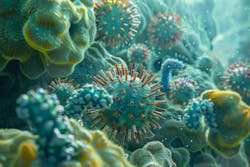Researchers at the Johns Hopkins Kimmel Cancer Center, Children’s Hospital of Philadelphia, the University of Pittsburgh and Weill Cornell Medicine discovered a novel cause of cytokine storm — the extreme inflammatory response associated with increased risk of death in COVID-19 infection.
Their findings were reported November 27 in the online issue of Proceedings of the National Academy of Sciences.
In an intensive genomic search for causes of cytokine storm, the research team used autopsy samples obtained from 40 patients who died from COVID-19. They performed genome analysis on samples taken from multiple sites, including the lung, heart, liver, kidney, lymph nodes in the chest that initially filter the virus, and the nasal cavity where the virus enters the body.
They zeroed in on some 50 upregulated immune genes in the samples obtained from nasal swabs and followed through in the genomics for the autopsy tissues.
Stephen Baylin, M.D., Virginia and D.K. Ludwig Professor for Cancer Research and co-senior author, and first author Michael Topper, Ph.D., Evelyn Grollman Glick Scholar and instructor in oncology, were familiar with many of the genes as part of the inflammasome, a protein signaling network they helped define that is activated to rid the body of virus or bacteria-infected cells.
“Some of the same genes involved in overactivation of the inflammasome appear to be key immune gene regulators of the hyperinflammatory process that leads to a new view of how these subsequently activate the “cytokine storm syndrome” and severely damage multiple tissues, says Topper.
The genes should turn on and off, Baylin explains, but when they stay on, it results in cytokine storm, the very severe inflammation that can be lethal to patients with COVID.
Essentially, immune genes in the nasal cavity, where the virus enters, send signals downstream through a system called renin-angiotensin-aldosterone system (RAAS) to initiate cytokine storm.
RAAS, a hormone system that normally turns on and off to help regulate blood pressure, body fluids and electrolytes, is the spark that pushes the immune response into overdrive, the researchers found, compromising the infection-fighting function of lymph nodes and causing severe damage to the lungs, kidneys, heart, liver and other organs.
“Markers of this inflammatory response in patients who die from COVID-19 can be detected in the blood, making it possible to identify patients at risk for developing the most severe and deadly COVID-19 infections and pointing to possible ways to intervene with drugs,” says Baylin.
The researchers also believe their findings may have implications for long COVID, a chronic condition following COVID-19 infection that is characterized by a wide range of symptoms, including fever, fatigue, coughing, chest pain, heart palpitations, headaches, joint and muscle pain, gastrointestinal issues and more. This is a focus of ongoing research, Topper and Baylin say.

